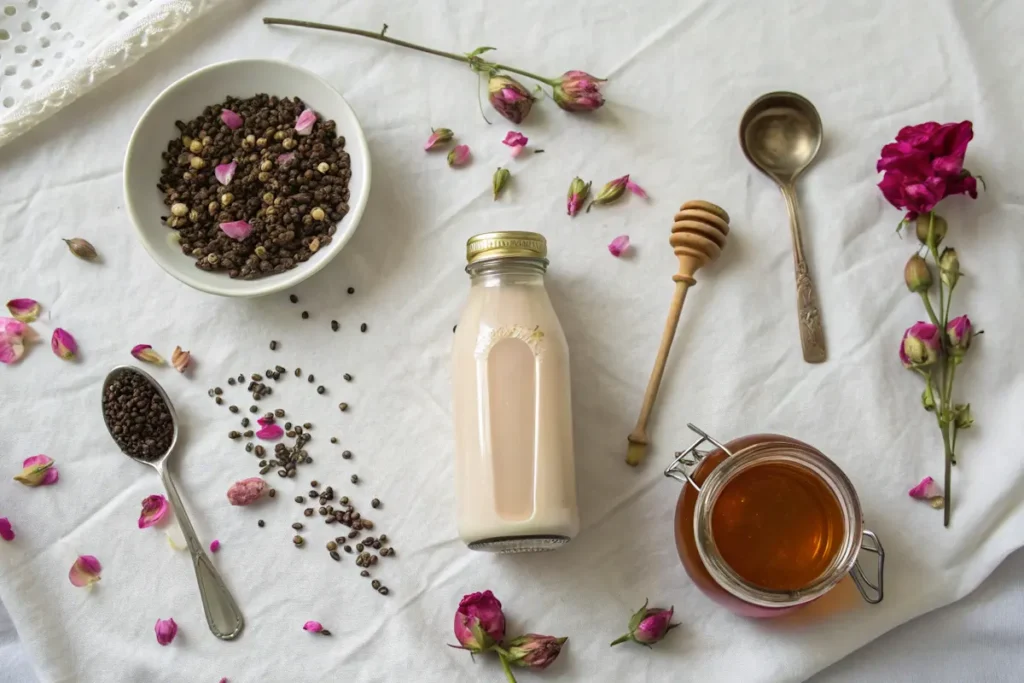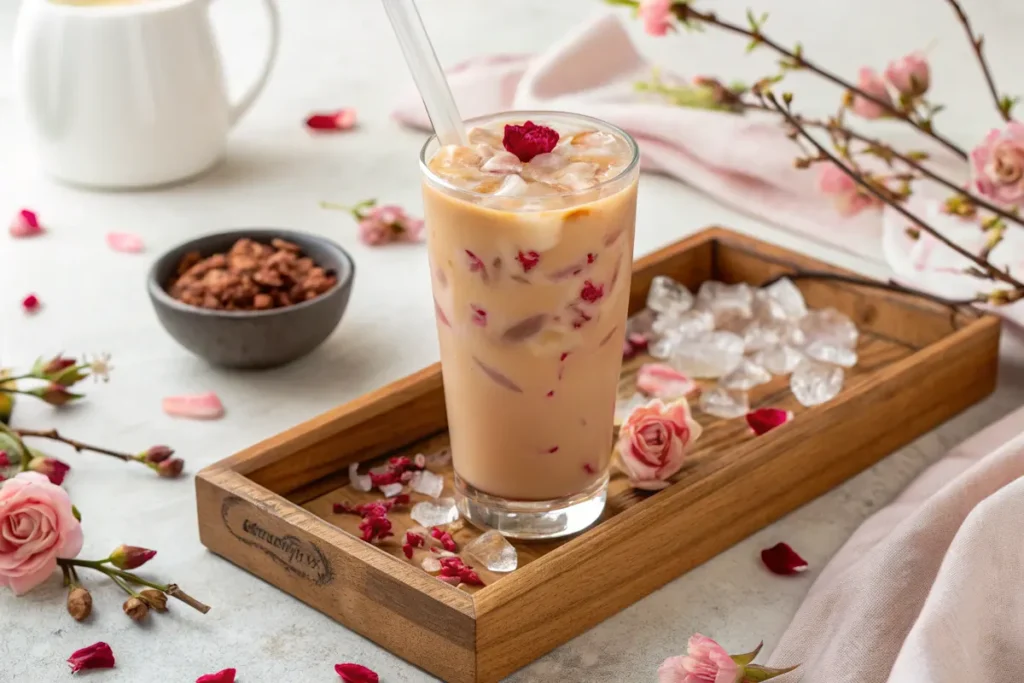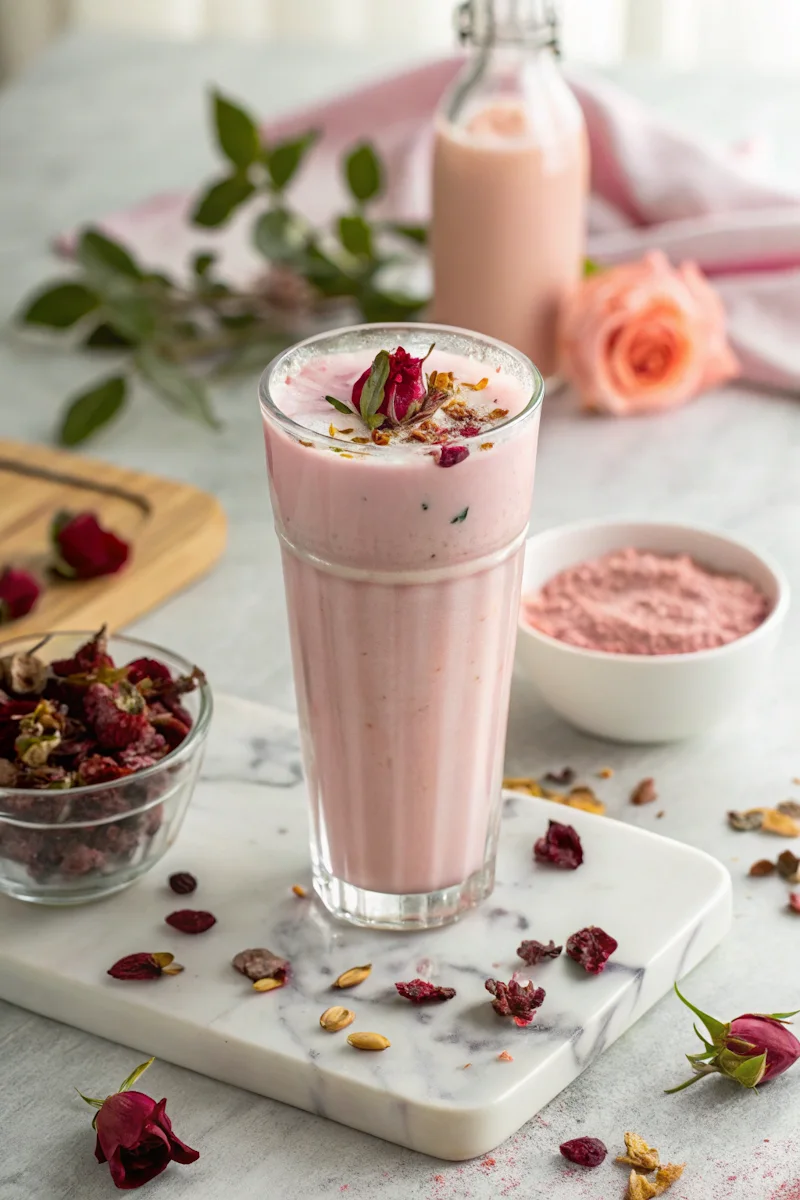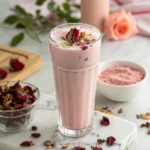Imagine indulging in a drink that’s as beautiful to behold as it is delightful to taste, carrying the timeless fragrance of a blossoming garden. That’s the essence of Rose Milk Tea – a truly enchanting beverage. Delicately floral, softly sweet, and visually elegant, this drink combines the aromatic depth of rose with the creamy comfort of milk.
Rose Milk Tea is made by blending food-grade dried rose petals or rose water with warm milk and, optionally, a base tea like black or green. The result is a soothing tea that’s both calming and luxurious, perfect for those who enjoy floral milk tea with a romantic touch.
Its elegant flavor profile, calming aroma, and photogenic pink hue have made it a favorite in cafes and home kitchens alike. It’s a soothing tea ideal for slow mornings or gentle afternoons. While our previous guide explored the exquisite Sakura Rose Milk Tea, this article delves specifically into the timeless charm of pure rose.
From childhood, my kitchen was my sanctuary – filled with the aroma of floral syrups and warming spices. Today, I share easy, soul-nourishing recipes like this one to help you bring a little beauty into your daily rituals.
This comprehensive guide will unveil the secrets to crafting your ideal Rose Milk Tea, delving into the types of rose to use, step-by-step recipes, potential benefits, and creative variations to personalize this elegant floral brew.
Table of Contents
The Allure of Rose: Crafting Your Perfect Rose Milk Tea
Delicately floral and softly sweet, Rose Milk Tea combines the aroma of roses with the creamy comfort of milk for a calming and elegant beverage.
- Prep Time: 5 minutes
- Cook Time: 5 minutes
- Total Time: 10 minutes
- Yield: 1 serving 1x
- Category: Beverage
- Method: Steeping
- Cuisine: Asian-Inspired
- Diet: Vegetarian
Ingredients
- 1 tbsp dried rose petals or 1–2 tsp rose water
- 1 black or green tea bag (optional)
- 1 cup milk of choice (whole, oat, almond, coconut, etc.)
- 1 tsp sweetener of choice (honey, simple syrup, stevia, etc.)
- ¾ cup filtered water
Instructions
- Steep dried rose petals in hot (180–200°F) filtered water for 5 minutes. If using rose water, add later.
- Optionally brew the tea bag separately and mix with the rose infusion.
- Heat the milk until steaming and froth with a whisk or frother.
- Combine the rose infusion and warm milk in a cup.
- Add sweetener to taste and stir gently.
- Garnish with edible rose petals or a dried rosebud for presentation.
Notes
Use only food-grade, pesticide-free rose petals or quality rose water. Avoid artificial extracts. Serve in clear glass for visual appeal.
Nutrition
- Serving Size: 1 cup
- Calories: 120
- Sugar: 10g
- Sodium: 60mg
- Fat: 5g
- Saturated Fat: 2.5g
- Unsaturated Fat: 2.5g
- Trans Fat: 0g
- Carbohydrates: 13g
- Fiber: 0g
- Protein: 4g
- Cholesterol: 15mg

II. The Essence of Rose: Varieties & Benefits
Choosing Your Rose: Petals, Buds, or Water?
When making rose milk tea, ingredient quality is everything. The most traditional method uses dried rose petals or buds, which must be food-grade and pesticide-free. Damask roses are a popular variety known for their delicate flavor and rich scent. Petals offer a lighter aroma, while whole buds create a fuller infusion.
Rose water is another option. It’s made through steam distillation of rose petals and provides a bold, concentrated fragrance. A few drops go a long way – too much can quickly turn soapy, so add it sparingly after steeping or blending.
Rose hips, the fruit of the rose plant, are packed with vitamin C and often used in standalone teas. However, they have a tart, fruity flavor and are less suitable for creamy milk tea blends.
To preserve the elegant essence of this drink, avoid artificial rose extracts. Natural rose ingredients ensure you get the real floral character and a much smoother tea experience.
The Bloom of Wellness: Potential Benefits of Rose Tea
Rose tea may not be as antioxidant-rich as green tea, but it offers its own bouquet of gentle benefits. The petals contain natural antioxidants that support cellular health and anti-inflammatory properties that may soothe internal discomfort.
Rose is also known for its calming effects. The scent of rose has been used for centuries in aromatherapy to reduce anxiety and elevate mood. Enjoying a cup of rose milk tea can offer not only hydration, but a moment of quiet and emotional reset.
There’s also anecdotal evidence that rose tea supports skin health, both due to hydration and antioxidant content. It’s gentle on the stomach and may offer mild digestive relief.
And don’t forget the joy of it – a beautiful drink that invites mindfulness and presence. Sometimes, the best benefit is the moment of calm it provides.
III. The Creamy Foundation: Selecting Your Milk & Sweeteners
Dairy & Plant-Based Milks for Optimal Creaminess
The milk base you choose will determine the texture and overall balance of your rose milk tea.
- Whole Milk or 2% Milk gives you that traditional, indulgent latte feel.
- Oat Milk is the plant-based favorite. It’s neutral, creamy, and supports floral notes without overpowering them.
- Almond Milk (unsweetened) brings a subtle nutty note and light texture.
- Coconut Milk, either light or full-fat, adds a soft tropical whisper – perfect if you want something unique, similar to what we explored in Coconut Milk Green Tea.
For a foamy, café-style finish, oat and whole milk froth particularly well.
Sweetening with Care: Enhancing, Not Overpowering
Rose milk tea shines when it’s only lightly sweetened. Opt for:
- Simple syrup, honey, maple syrup, or agave for natural sweetness.
- Stevia or monk fruit for a no-sugar option.
Start with a small amount and taste as you go – your goal is to elevate the floral notes, not drown them out. For calorie-conscious versions, visit our guide on milk tea calories.
IV. Crafting Your Rose Milk Tea: Hot & Iced Recipes
Classic Hot Rose Milk Tea Recipe
Printable Recipe Card Placeholder
Ingredients:
- 1 tbsp dried rose petals or 1–2 tsp rose water
- 1 black or green tea bag (optional)
- 1 cup milk of choice
- 1 tsp sweetener of choice
- ¾ cup filtered water
Instructions:
- Infuse the Rose: Steep petals in hot (not boiling) water at 180–200°F for 5 minutes. For rose water, add later.
- Add Tea Base (Optional): Brew tea separately and combine with rose infusion for stronger body.
- Warm and Froth Milk: Heat milk until steaming, then froth using a whisk or frother.
- Combine: Mix rose infusion and milk. Add sweetener to taste. Top with rose petals.
Pro Tips: Avoid boiling rose petals. Use filtered water to preserve clarity. Serve in a warmed mug to maintain heat.
Refreshing Iced Rose Milk Tea Recipe
Make the rose infusion first, then chill it completely. Pour over ice and top with chilled milk. Garnish with fresh rose petals for a stunning summer drink. Use a larger glass to show off the delicate layers. You can also create a rose milk tea latte by increasing the milk ratio.
Aesthetic Presentation
Use clear glassware to let the soft pink color shine. Garnish with:
- One or two edible rose petals (unsprayed)
- A single dried rosebud
- Optional: matcha powder on top for contrast
V. Expanding Your Rose Horizons: Variations & Pairings
Creative Rose Milk Tea Twists
Experiment with the base:
- Earl Grey creates a floral-citrus twist (Rose Earl Grey Latte).
- White tea brings a mild, delicate touch.
- Green tea adds earthy notes, as seen in Matcha Green Tea with Coconut Milk.
Want fruit? Try a splash of lychee syrup or raspberry purée.
Spices? Add a pinch of cardamom or vanilla extract.
Craving texture? Add boba pearls, lychee jelly, or crystal boba – just keep an eye on sugar content. (See our guide on bubble milk tea calories).
For those who enjoyed the delicate complexity, our recipe for Sakura Rose Milk Tea offers a beautiful seasonal variation.
If you’re captivated by floral infusions, explore Jasmine Milk Tea or Lavender Milk Tea for different aromatic experiences.
Culinary Companions
This soothing tea pairs beautifully with light shortbread cookies, fruit tarts, or rosewater macarons. The key is to match its delicate elegance with equally refined snacks.

FAQs:
What is rose milk tea made of?
Rose milk tea is typically made from a blend of food-grade dried rose petals or rose water, combined with milk and sometimes a base tea like black or green tea. A light sweetener such as honey, simple syrup, or stevia is often added to enhance the floral notes without overpowering them. The result is a creamy, aromatic drink that’s soothing and visually elegant.
What does rose milk taste like?
Rose milk has a gentle, floral sweetness with a perfume-like aroma. The flavor is light and smooth, slightly reminiscent of Turkish delight or rosewater desserts. When combined with milk, it becomes velvety and calming—ideal for a relaxing treat that’s both elegant and comforting.
Is rose tea good with milk?
Yes, rose tea pairs beautifully with milk, especially when balanced correctly. The floral notes of rose are complemented by the creaminess of milk, creating a soft, luxurious texture. It’s important to use high-quality rose petals or rose water and to avoid artificial flavors to ensure the milk doesn’t overpower the delicate floral profile.
What does rose tea taste like?
Rose tea tastes floral, lightly sweet, and soothing. Depending on the type of rose used, the flavor may be subtle and herbal or more fragrant and fruity. Unlike other floral teas, rose tea has a soft, romantic flavor that evokes the feeling of spring. It’s especially lovely on its own or as a base for drinks like rose milk tea.
VI. Conclusion: The Simple Elegance of Rose
There’s something timeless and healing about Rose Milk Tea. It’s not just a drink—it’s a ritual, a pause, a fragrant reminder to slow down. Whether served warm or iced, sweetened or not, its soft beauty and calming nature are accessible to everyone.
Embrace the floral simplicity. Brew your perfect rose milk tea and let each sip be a little act of self-care.



7 thoughts on “The Allure of Rose: Crafting Your Perfect Rose Milk Tea”